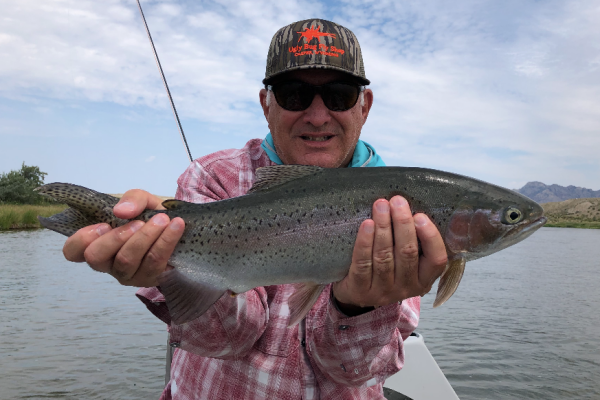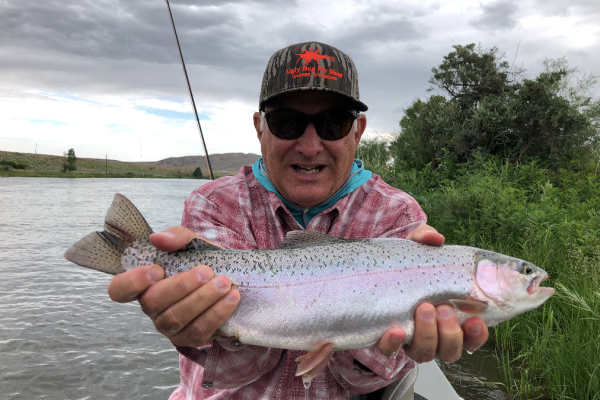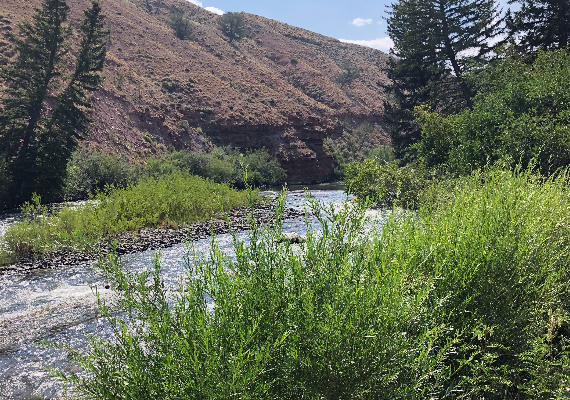Ever since I began summer fly fishing trips to Colorado about 15 years ago, Jim Daniel has been pointing me to Casper, Wyoming.
Go north, young man! There is breath-taking fly fishing. It is a bucket list place.
Not that the rivers where Jim, a transplanted Arkie, took me in Colorado were poor for fly fishing. The headwaters of the North Platte in the Walden area, the Frying Pan near Basalt, the South Platte near Deckers and the Colorado near Kremmling are famous and provide a chance at a trophy trout.
“But for really BIG fish, you need to drive to Casper,” Jim said. “Fish the Miracle Mile of the North Platte. They are bigger there and they fight harder. It’s as good as you have back home in Arkansas.”
That’s a mouthful. The White River has brutes, browns that can break the world record. On our river, a 20-inch brown is now common, a two-footer a regular happening and 30-inch fish are caught several times per month.
Every time I go west to fish, someone there finds out I live near the White River and they say, “Why did you come here? You are in the greatest spot for big browns in the lower 48.”
No doubt, that’s true. It was sort of mentioned again at the start of my day with Michael (Fly) Graham, one of the top guides at Crazy Rainbow Fishing, the arm of Casper’s best fly shop, The Ugly Bug.
In front of the drift boat of Michael (Fly) Graham, who guides for Crazy Rainbow Fishing.
After telling Graham my backyard is the White River, he said, “I’ll come fish with you. I know about your big browns. We have them here, too, but you have more. But you don’t have our big, fat rainbows.”
There was no argument that the Miracle Mile of the North Platte has all kinds of monster trout, big browns and rainbows. It’s been on my bucket list for the last decade.
Graham made no promises when I met him at 6:10 a.m. Friday at the lodge, 25 miles south of Casper. He said “the Mile” had been fishing so-so, but some good fish were being caught. I was just a few days late for the hot dry fly action with adult stone flies. We’d have to go deep to fool trout with stone fly nymphs and a split case baetis midge.

An adult stone fly.
Crazy Rainbow has another option, floating Grey Reef. It produces smaller fish, but in greater numbers. I’d signed up for “the Mile” and a better shot at a two-foot trophy trout.
So off we went, in two vehicles. I was solo (neither Daniel or another Colorado buddy, Jeremiah Gage) could wiggle free from work.
“We do the shuttle ourselves,” Graham said, meaning he and I. “We’ve got a 53-mile drive to the launch point.”
“The Mile” is a gentle meadow river in high desert with a couple of rapids between two reservoirs. It’s below Pathfinder Dam and is a nutrient rich tailwater. It had a steady 2,000 cfs flow on our float. It’s actually about five miles long and we did most of it.
Graham rows a stable Clackacraft drift boat. There is a 3.5 hp motor to get out of trouble if the wind turns nasty. There’s always wind in Wyoming, but 30 mph can make it impossible to row through 4-foot swells when it is blowing up river.
There was hardly a breeze on our float and the cloud cover held until after lunch. It was under 80 degrees for most of the day and just as perfect as the fishing. I started with two layers and needed them until after lunch.
I had brought three rigged rods in my truck’s roof top vault and more in tubes, but I elected to fish Graham’s Orvis Helios 3 for 6 weight line. We fished three flies most of the day. I have top end stuff but mostly lighter weights.
“You will be under gunned for our big fish with your four and five (weight rods),” Graham said. “Lets just fish mine and they are already rigged with three flies.”
That was great advice, just like everything else he said that day. Graham is top shelf and I’ve fished with the best guides in Arkansas, Pennsylvania, Colorado and Montana.
There was the usual stone fly nymph up top, a wine San Juan worm in the middle and a size 18 split case Baetis nymph on bottom.
Fishing was spectacular. Since I was alone with Graham, I had the front of the boat where the catch ratio is 5-to-1 over the back. I could fish in front of the boat or cast to the back area of the drift if I wanted to hit a spot twice.
I soon discovered that the second part wasn’t necessary. If it was a good stretch, Graham put his boat in the slack water and rowed back to the top of the run for a second, third or fourth trip through the best stretches.
It didn’t take long to find out that the trout in “the Mile” are incredible fighters. And, they are all big. I didn’t catch more than a dozen trout, but all were in the 20-inch range. More than half were pushing 24 inches.

A Miracle Mile rainbow trout, a hefty and hard fighter.
At the end of the day, Graham said, “None of those were 24, but several were close. When it’s good here, you can catch several that are over 25.”
They were all fat and strong, wild fish. It’s pretty common to get a hard run towards the middle of the river where the current is fast and bumpy. What follows takes your breath away, two or three big, twisting jumps.
With great respect for such a fish and the tailwater, I thought I’d let Graham hold the fish for pictures. That wasn’t going to do. He wanted me to get pictures with the fish before they were safely released.
“You’ve fished enough to know how to do this,” he said, then gave me a refresher course on the right way to handle a trophy for a photo.
“Wet your hand under the net and get a little fish slime,” he said. “Grab the tail, cradle the under side and we’ll get three or four in five seconds and then get them back in the river.”
I didn’t drop one fish, but if I had, the net was positioned under the fish for a save and a soft landing. That’s the sign of a great guide.
Except for the fight, it was easier fishing than I suspected.
Graham put the drift boat near the bank and I cast to seams towards the middle of the river. My cast only needed to be 15 to 20 feet. They were little more than lobs and the constant mends (up or down) were easy.
I kept my flies in the water most of the day, the way a good nympher is trained. There was not a lot of casting and so there were only two times where my three flies were tangled. The only trick was to keep moss off the flies and split shot.
As we finished the day, there was some pride when I reminded Graham that we had not lost a rig to a bottom snag, broke off a fish or any other mishap. In other words, we just fished. We lost zero flies.
That is probably a little bit of luck, but some skill. That’s exactly how I’d rate the last fish of the day, a 23.5-inch brown that excited Graham.
“We are about to hit a good bend and a good seam,” Graham said. “We’ll hit it two or three times, but it’s a spot that we might nail a big brown. Be ready for the first cast into that seam and give it a quick up stream mend.”
About the time I made the mend (and probably moved the flies), my indicator plunged and I set on the strongest fish of the day. There was a big run to the gut of the white water. Another guide boat was on the other side of the river and the anglers signaled that it was a big fish. They got a better view of that first jump than we did.
What we didn’t know was that they recognized it was a big brown. We didn’t learn that until it had made three more jumps, then sailed to our side of the river. Graham netted it on the first swing near the boat.
When it rolled near the surface maybe 20 feet from the boat, Graham shouted, “It’s a big brown. Get it in and you are in the 3% club.”

A Miracle Mile rainbow trout.
I felt a little pressure then, but ignored my throbbing right elbow and worked the fish to Graham’s net.
After that, he explained, “We know that only 3% of the fish caught on ‘the Mile’ are brown trout. That’s a true trophy.”
I was already excited, but that gave me goose bumps. My guide extended a fist and I busted it hard with a closed shaking right hand. It’s the greatest feeling in fly fishing, true exhilaration!
The whole day was an incredible experience. I’ve caught big fish before, but none had fought any harder or made my limbs quiver over and over. I changed hands twice during the fight with the brown, a fight that tested the spline of a stout Helios 3.
We took pictures in the net and then got some quick shots with both of our phones, since his features a better lens. They turned out wonderfully. A good guide does that perfectly.
We hit that run a couple more times and landed another nice rainbow, but no more browns. There was only one for the day and it hit below the averages. It turned out to be less than 1 percent of our catch.
It was the highlight of a seven-day swing through Colorado and Wyoming, one that featured several change in plans because of fires and floods in Colorado.
Fishing “the Miracle Mile” was always in the plan. The date with Graham was booked two weeks in advance. But there was supposed to be some Colorado fishing with Gage or Daniel.
We thought we might drive to the Walden area, but floods knocked out a road next to the Poudre River above Fort Collins. There were fires near some streams around Steamboat Springs that knocked out several of my other favorite spots.
A guide Jim and I used last year warned us that the Colorado River was running low and hot, dangerous for fish. So that option was dumped ahead of the trip to Casper.
The early part of the week was spent mainly resting at Gage’s house and dining on his gourmet meals. We had played golf in the backyard of his Loveland home, at Miriana Butte. There was also a lunch at TPC Colorado where Arkansas grad Tag Ridings won two weeks ago. The night after the lunch Gage came up with a plan ahead of the Casper trip.
“Why don’t you go see the Wind River in northwest Wyoming?” Gage said. “I think it’s about six hours from here, then you just have about three hours to Casper. If you go to the Frying Pan or other rivers in Colorado, you are headed the wrong direction from Casper.”

The Wind River near Dubois, Wyoming.
Off I went the next morning, seeing gorgeous vistas on a circle route through Wyoming. Two days fishing the Wind River netted a few small fish, but that’s to be expected in a new place without a guide. I lost a nice cutthroat just short of the net, confirmation that the Wind River has large, wild fish.
The goal all along was the trip down “the Mile.” My Mountain Home buddy, Wapsi executive TL Lauerman, had provided the correct scouting report on the eve of my trip.
“You are going to have the best day of fishing of your life on that section of the North Platte,” Lauerman said. “There is no place outside of Alaska where you will catch as many big, hard fighting trout in one day. You will absolutely love it and you will go back.”
During the shuttle ride back to my truck, I told Graham there would be another trip. We exchanged phone numbers. He may come fish with me in Arkansas. He knows there are big brown trout with his name on them in the White River.
I’m sure Crazy Rainbow has other great guides, but I loved Michael. He’s a fourth generation Wyomingite. His grandfather was director of Wyoming Game and Fish. He’s got the right genes and the love for one of the world’s great trout rivers. He is making his grandfather proud.
Casper deserves a closer look, too. Graham promised a scouting report on the best steak houses for my return. I found a good one, but not one in his top three.
There were also tips on how to do the Wind River next time. He suggested Thermopolis as a new starting point. And there were some tips for south Wyoming on the Encampment, a tributary of the North Platte. Gage and I had apparently not found the best stretch last summer.
We had a long visit at the take-out point plotting next year’s possibilities. He handed me three flies to try on the White River, a streamer made with a strip of mink.
“It’s a zurtle bug,” he said. “I don’t use them much because they are pretty expensive.”
Back in Arkansas, they were presented to Kristopher Bouldin, my guide son-in-law. He looked at them once, stuck them in the bill of his cap and said, “Tell (Graham) to come down here and we will fish them together.”
I want to be a fly on the wall (or the third in the boat) when Fly gets to the White River.
Credit: Source link






























